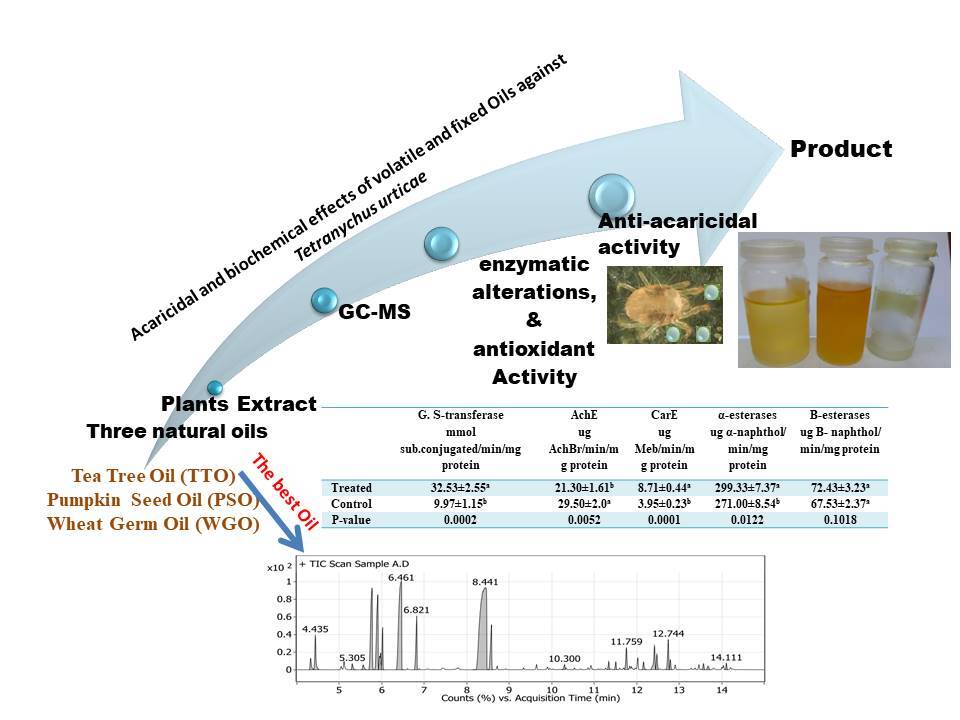ORIGINAL ARTICLE
Natural Oils as Botanical Acaricides: Linking Chemical Composition, Enzymatic Disruption, and Antioxidant Capacity in the Control of Tetranychus urticae
1
2Medicinal and Aromatic Plants Research Dept, national research centre, 33 El Buhouth St, Ad Doqi, Dokki, Cairo Governorat, 12622, El Doki, Egypt
2
Vegetable and Ornamental Plant Mites Depr., Plant protection Research Institute, Agricultural Research Center, Cairo, Egypt,, 33 El Buhouth St, Ad Doqi, Dokki, Cairo Governorat, 12622, El Doki, Egypt
These authors had equal contribution to this work
A - Research concept and design; B - Collection and/or assembly of data; C - Data analysis and interpretation; D - Writing the article; E - Critical revision of the article; F - Final approval of article
Submission date: 2025-05-11
Acceptance date: 2025-09-17
Online publication date: 2025-10-27
Corresponding author
Mona A Mohammed
2Medicinal and Aromatic Plants Research Dept, national research centre, 33 El Buhouth St, Ad Doqi, Dokki, Cairo Governorat, 12622, El Doki, Egypt
2Medicinal and Aromatic Plants Research Dept, national research centre, 33 El Buhouth St, Ad Doqi, Dokki, Cairo Governorat, 12622, El Doki, Egypt
HIGHLIGHTS
- • Tea tree oil showed strongest acaricidal activity against Tetranychus urticae
- • Pumpkin seed and wheat germ oils showed moderate acaricidal effects
- • Tea tree oil significantly increased GST, CarE, and α-esterase levels in mites
- • Acetylcholinesterase activity decreased after exposure to tea tree oil
- • Natural oils offer eco-friendly alternatives for managing spider mite infestations
KEYWORDS
TOPICS
ABSTRACT
The two-spotted spider mite (Tetranychus urticae Koch) is a major agricultural pest, with increasing resistance to synthetic pesticides thereby, driving the search for natural alternatives. This study evaluated the acaricidal and antioxidant activities of tea tree oil (TTO, Melaleuca alternifolia (Maiden and Betch) Cheel), pumpkin seed oil (PSO, Cucurbita pepo L.), and wheat germ oil (WGO, Triticum aestivum L.) against T. urticae. Laboratory trials determined LC50 and LC90 values for adults and eggs. Biochemical effects on mites surviving TTO exposure were assessed by analyzing Glutathione S-transferase (GST), Acetylcholinesterase (AchE), Carboxylesterase (CarE), and α-esterases activities. Antioxidant activity was evaluated via DPPH and ABTS assays. Gas Chromatography-Mass Spectrometry (GC-MS) identified 24 compounds in TTO, with 4-Terpineol (36.65%) and γ-Terpinene (17.66%) as major components. TTO showed the highest acaricidal activity (LC50 of 0.3% for adults and 1.8% for eggs), outperforming PSO and WGO. TTO exposure significantly disrupted key enzymatic activities, impairing mite survival. Among the oils, TTO exhibited the strongest antioxidant activity. The antioxidant assays revealed that while all three oils demonstrated dose-dependent antioxidant effects, TTO was markedly more effective than PSO and WGO, although less potent than vitamin C and Trolox. Additionally, TTO exposure resulted in significant reductions in detoxification enzyme activity, particularly GST and AchE, highlighting a biochemical mechanism underlying its acaricidal action. The lipophilic properties of TTO likely enhance its penetration through the mite cuticle, increasing its efficacy. These findings support the use of plant-derived oils as eco-friendly alternatives for sustainable pest management and suggest potential for further development into natural pesticide formulations.
CONFLICT OF INTEREST
The authors have declared that no conflict of interests exist.
Share
RELATED ARTICLE
We process personal data collected when visiting the website. The function of obtaining information about users and their behavior is carried out by voluntarily entered information in forms and saving cookies in end devices. Data, including cookies, are used to provide services, improve the user experience and to analyze the traffic in accordance with the Privacy policy. Data are also collected and processed by Google Analytics tool (more).
You can change cookies settings in your browser. Restricted use of cookies in the browser configuration may affect some functionalities of the website.
You can change cookies settings in your browser. Restricted use of cookies in the browser configuration may affect some functionalities of the website.




